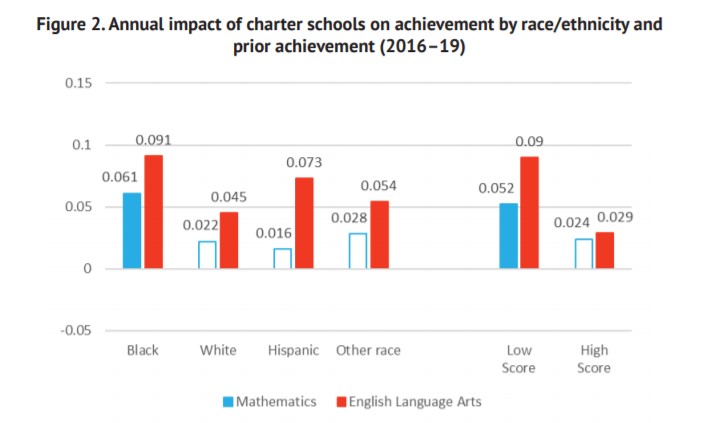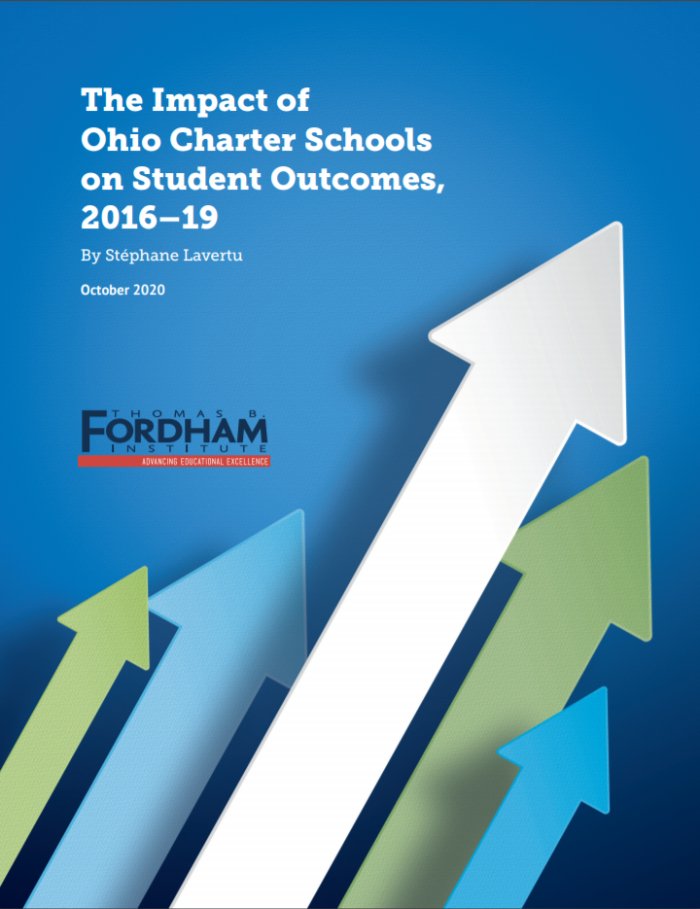Earlier this month, the Thomas B. Fordham Institute released a special report titled “The Impact of Ohio Charter Schools on Student Outcomes, 2016–19.” The report concludes that charter school attendance, particularly over a longer period spanning fourth through eighth grade, has a positive impact for students both academically and behaviorally. Students who attend charter schools during these years are more likely to be more proficient in math and English language arts (ELA) and are less likely to be chronically absent or to have disciplinary incidents. These improvements are especially seen in among the students who have the most to gain: minority, low-income, and low-achieving students, whose performance often lags behind that of their White and more affluent peers.
The report highlights seven major findings:
- Students attending Ohio charter schools showed larger achievement gains, moving the average charter school student from the thirtieth to the fortieth percentile in ELA after attending from fourth grade through eighth grade.
- Attending charter schools leads to improvements in other outcomes associated with education success, particularly when it comes to disciplinary incidents and chronic absenteeism.
- Black and low-achieving students in urban environments benefit the most from attending charter schools: Black students’ achievement gains in grades four through eight are twice as large as White students’, and every year a Black student attends a charter school in these years, their probability of being reported for a disciplinary incident decreases by an additional three to four percentage points. Attending a charter high school makes a significant difference in attendance rates between Black students and the average Ohio student.
- Charter schools that contract with nonprofit management organizations have the largest effect on student achievement.
- Attending a charter high school has no impact on the probability that a student eventually receives a diploma.
- Low-achieving students benefit most from attending charter high schools, averaging on average 0.5 points higher on the ACT than a similar student at a traditional high school.
- Charter schools in Columbus, in particular, are notable for their consistently large positive impacts at all grade levels and across nearly all outcomes.
In light of the continued Yazzie/Martinez lawsuit, where plaintiffs claimed the state was leaving at-risk students and students with disabilities behind due to insufficient education funding, some of the most interesting findings for our purposes may be the ones that show impressive improvement among students like these (the report classifies students scoring in the sixteenth percentile as “low-achieving” students, but it should be noted that historically, there’s an unfortunate correlation between a low-income, minority background and low achievement).
The study concludes, “These results are consistent with evaluations of high-performing charter sectors around the country, which tend to find that minority, low-achieving, and low-income students benefit most from charter school attendance.” The graphs below show the impact of charter schools on student achievement in math and ELA, and the cumulative impact of charter school attendance over the course of several years.


It’s worth recalling New Mexico’s student makeup: of our approximately 330,000 students, many (if not a majority) them fall into the at-risk group that the Yazzie/Martinez sufficiency lawsuit defined as low-income students, Native American students, English learners, and students with disabilities. Here is the New Mexico Public Education Department breakdown of all 295,000 public school students who took the PED assessment in 2019:
- 74.0% economically disadvantaged
- 58.8% Hispanic
- 16.8% English language learners
- 15.3% students with disabilities
- 12.0% Native American
- 3.7% African American
- 3.7% mobile (falling into the categories “migrant,” “homeless,” and “foster”) (PED and the federal Department of Education typically consider mobile students at-risk as well, due to the many and frequent disruptions they experience in their education.)
This Ohio study is an important addition to scholarship proving charters’ potential in boosting student achievement, but it underscores the importance of continued assessment of charters – and traditional public schools – that serve these students who are on the losing side of the achievement gap.
Perhaps moreover, it illustrates the opportunity for our state to contribute to the national effort to quantify charter schools’ impact and efficacy, especially where at-risk students are concerned. In recent years, New Mexico legislators’ interest, particularly among those with ties to traditional public schools, has centered around studying the cost of charter schools, not their outcomes. Many maintain that it costs the state more to educate a charter student than a traditional public school student, despite budget data that disproves this – and powerful studies like Fordham’s that show the potential for a robust return on investments made in charter schools.





